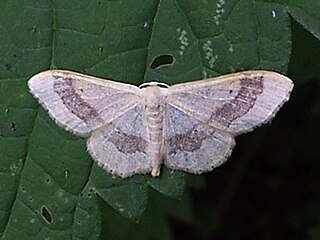
Pleochroism is an optical phenomenon in which a substance has different colors when observed at different angles, especially with polarized light.

The riband wave is a moth of the family Geometridae. The species was first described by Carl Linnaeus in his 1758 10th edition of Systema Naturae.

The large tortoiseshell or blackleg tortoiseshell is a butterfly of the family Nymphalidae.

Athyma nefte, the colour sergeant, is a species of brush-footed butterfly found in tropical South and Southeast Asia.
Choerophryne sanguinopicta is a species of frogs in the family Microhylidae. It is endemic to southeastern Papua New Guinea and only known from the vicinity of its type locality, the northern slope of Mt. Simpson in the Owen Stanley Range, Milne Bay Province, although it is expected to occur more widely. The specific name sanguinopictus, from Latin for sanguis ("blood") and pictus ("painted") refers to the distinctive red blotching and punctations characteristic for this species.
Pithanurga is monotypic moth genus in the family Gelechiidae. Its only species, Pithanurga chariphila, is found in South Africa. Both the genus and species were first described by Edward Meyrick in 1921.
Sphaerolbia is a genus of moth in the family Lecithoceridae. It contains the species Sphaerolbia chrematistis, which is found in India (Assam).

Anarta myrtilli, the beautiful yellow underwing, is a moth in the family Noctuidae. The species was first described by Carl Linnaeus in 1761. It is found in most of Europe including Scandinavia, Britain, France, Germany, Switzerland, Spain, Portugal, Italy, and Russia.

Dichrorampha alpinana, the broad-blotch drill, is a species of moth of the family Tortricidae. It is found in almost all of Europe.
Aeolanthes diacritica is a moth of the family Depressariidae. It is found in India (Assam).
Aeolanthes meniscias is a moth of the family Depressariidae. It is found in Burma.
Doxogenes brochias is a moth in the family Lecithoceridae. It was described by Edward Meyrick in 1905. It is found in Sri Lanka.
Aeolanthes ampelurga is a moth in the family Depressariidae. It was described by Edward Meyrick in 1925. It is found in northern India (Kumaon).
Aeolanthes callidora is a moth in the family Depressariidae. It was described by Edward Meyrick in 1907. It is found in India (Assam).
Aeolanthes cyclantha is a moth in the family Depressariidae. It was described by Edward Meyrick in 1923. It is found in southern India.
Aeolanthes deltogramma is a moth in the family Depressariidae. It was described by Edward Meyrick in 1923. It is found in India (Assam).
Aeolanthes dicraea is a moth in the family Depressariidae. It was described by Edward Meyrick in 1908. It is found in India (Assam).
Aeolanthes lychnidias is a moth in the family Depressariidae. It was described by Edward Meyrick in 1908. It is found in southern India.
Aeolanthes rhodochrysa is a moth in the family Depressariidae. It was described by Edward Meyrick in 1907. It is found in India (Assam).
Gonionota habristis is a moth in the family Depressariidae. It was described by Edward Meyrick in 1914. It is found in Guyana and Peru.





